AMD Threadripper 1950X and 1920X Out August 10th, New Eight-Core TR 1900X at $549 due Aug 31st
by Ian Cutress on July 30, 2017 10:30 PM EST
One of AMD’s skills in recent quarters is the ability to drip feed information about upcoming products slowly to the point where even the breath of a clock speed becomes another several column inches about an upcoming platform. Today’s announcements are as juicy as an average minute steak, giving details confirming the launch dates for the first two Threadripper processors, some in-house performance comparisons, and also information about a third cut of the ingot coming at the end of the month.
Related Reading
- The AMD Zen and Ryzen 7 Review: A Deep Dive on 1800X, 1700X and 1700
- The AMD Ryzen 5 1600X vs Core i5 Review: Twelve Threads vs Four at $250
- The AMD Ryzen 3 1300X and Ryzen 3 1200 CPU Review: Zen on a Budget
- AMD Launches Ryzen PRO CPUs: Enhanced Security, Longer Warranty
- How To Get Ryzen Working on Windows 7 x64
- AMD Launches Ryzen: 52% More IPC, Eight Cores for Under $330
Threadripper Gets a Launch Date
The news at the top of the hour is the date at which AMD is making Threadripper and associated TR4 based motherboards available at retail: August 10th. This is expected to be a full worldwide retail launch, so don’t be surprised if your favorite retailer starts posting teaser images about how much stock they have. August 10th will see both the 1950X and 1920X with their retail packaging, along with motherboards from the main four motherboard vendors.
The image used up the top was posted on Twitter a few days ago by AMD showing the retail packaging, and a Dr Lisa Su, CEO of AMD, for scale. The base retail package does not come with a cooler, but does come with a spacer and Torx wrench, as the socket requires a full Torx screwdriver to access it. AMD has engineered an ecosystem of both closed liquid loop coolers partners, as well as a few air coolers capable of meeting the 180W TDP required. We’re looking into exactly which models will have the appropriate support.
AMD is allowing pre-orders for partner systems and boutique OEMs to start from July 31st. Dell’s Area-51 Threadripper edition has been highly covered already, and it was always a question as to why they were allowed to announce earlier than everyone else. The answer was that they secured an exclusive, but it seems only for four days, from the 27th. Nonetheless, other system integrators such as MainGear, OverclockersUK, iBUYPOWER, Origin, Velocity Micro and others will be showing systems from today.
From the motherboard vendor side, this week has seen the main four companies lift the lid on some of their AM4 designs further to what we saw back at Computex. ASRock, ASUS, GIGABYTE and MSI will all be launching motherboards on day one, making full use of the quad channel memory with two DIMMs per channel and 60 PCIe lanes for add-in cards (using another four for the chipset, which we typically do not count to some users’ chagrin). We’re planning a full overview of each board, but keep eyes out for:
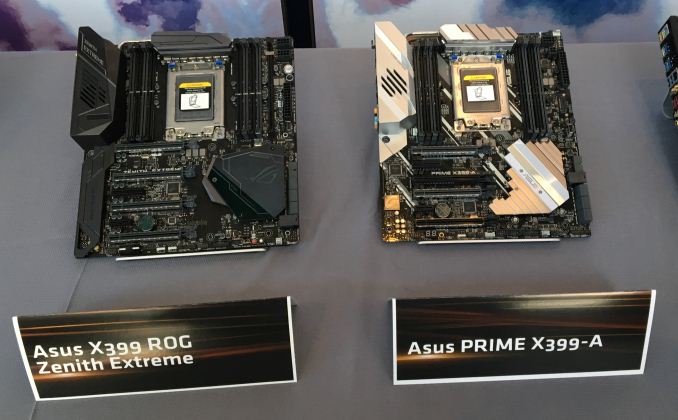 ASUS X399 ROG Zenith Extreme and ASUS PRIME X399-A
ASUS X399 ROG Zenith Extreme and ASUS PRIME X399-A
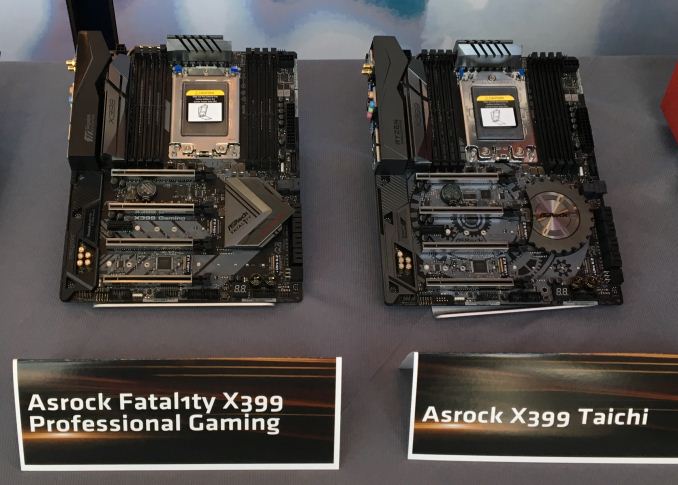
ASRock X399 Professional Gaming and ASRock X399 Taichi

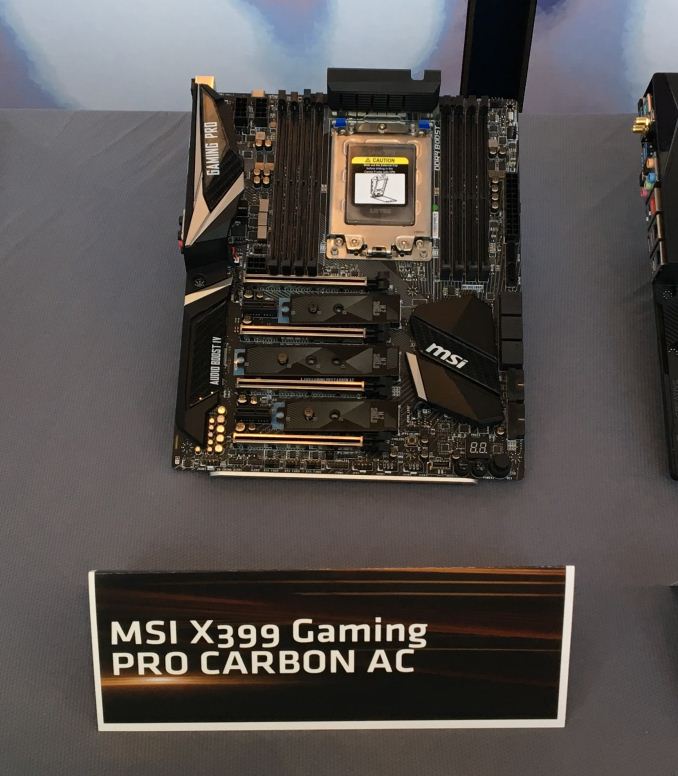
GIGABYTE X399 Gaming 7 and MSI Gaming PRO CARBON AC
At present all the boards being shown are ATX or E-ATX. We’re unlikely to see any mini-ITX due to the size of the socket however microATX might be possible further down the line. No word on pricing for these yet, except that one of the system integrators has priced the ASUS X399 Zenith at +$227 over the GIGABYTE X399 Gaming 7 in their configurator, which suggests the boards will range in price from $300 to $600 pretty easily (add in some knowledge we already have on the BOM cost of some of these parts).
Threadripper 1950X Performance: AMD Gave A Number
Having a few threads in hand at a high frequency means that any benchmark which is thread dense and register light is going to scale very well. AMD shared one data point (which we cannot confirm) from their recent favorite benchmark, Cinebench R15.
The number given was 4122, representing a 5.2 GHz overclocked (under liquid nitrogen, so not a daily OC) Threadripper 1950X. If we scale this down to 3.5 GHz for the all-core turbo of 1950X, we get a score more around 2774. One of the scores in the screenshot above is 3099, which equates to a 3.9 GHz all-core frequency.
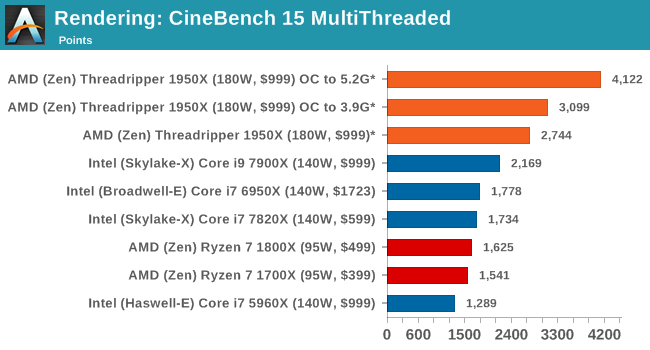
We have some old dual socket CB15 numbers in our database, under Windows 7. There are a fair number of old dual socket workstations around for compute tasks, and TR 1950X (if these numbers are true) beats systems such as a dual socket Ivy Bridge-EP based E5-2687W v3 when running all cores near turbo frequency, which would have retailed at launch for $4200+ just in processors and at a much lower TDP than two of the older processors combined.
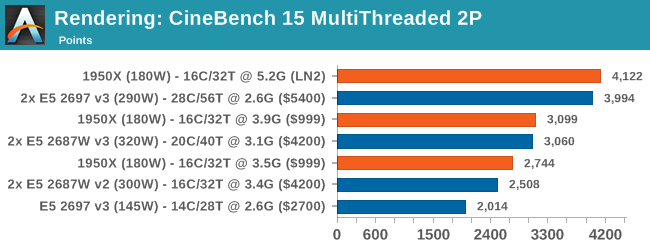
Threadripper The Third: The Threadripper 1900X at $549, coming August 31st
To sprinkle some salt onto the steak today is the announcement of a third TR processor. The 1900X is an eight-core part, with a base frequency of 3.8 GHz, a turbo of 4.0 GHz, and +200 MHz of XFR.
| AMD Ryzen SKUs | |||||||||
| Cores/ Threads |
Base/ Turbo |
XFR | L3 | DRAM 1DPC |
PCIe | TDP | Cost | Cooler | |
| TR 1950X | 16/32 | 3.4/4.0 | ? | 32 MB | 4x2666 | 60 | 180W | $999 | - |
| TR 1920X | 12/24 | 3.5/4.0 | ? | 32 MB | 4x2666 | 60 | 180W | $799 | - |
| TR 1900X | 8/16 | 3.8/4.0 | +200 | ? | 4-Ch | 60 | ? | $549 | - |
| Ryzen 7 1800X | 8/16 | 3.6/4.0 | +100 | 16 MB | 2x2666 | 16 | 95 W | $499 | - |
| Ryzen 7 1700X | 8/16 | 3.4/3.8 | +100 | 16 MB | 2x2666 | 16 | 95 W | $399 | - |
| Ryzen 7 1700 | 8/16 | 3.0/3.7 | +50 | 16 MB | 2x2666 | 16 | 65 W | $329 | Spire |
| Ryzen 5 1600X | 6/12 | 3.6/4.0 | +100 | 16 MB | 2x2666 | 16 | 95 W | $249 | - |
| Ryzen 5 1600 | 6/12 | 3.2/3.6 | +100 | 16 MB | 2x2666 | 16 | 65 W | $219 | Spire |
| Ryzen 5 1500X | 4/8 | 3.5/3.7 | +200 | 16 MB | 2x2666 | 16 | 65 W | $189 | Spire |
| Ryzen 5 1400 | 4/8 | 3.2/3.4 | +50 | 8 MB | 2x2666 | 16 | 65 W | $169 | Stealth |
| Ryzen 3 1300X | 4/4 | 3.5/3.7 | +200 | 8 MB | 2x2666 | 16 | 65 W | $129 | Stealth |
| Ryzen 3 1200 | 4/4 | 3.1/3.4 | +50 | 8 MB | 2x2666 | 16 | 65 W | $109 | Stealth |
There are some questions around why AMD would release an 8-core Threadripper, given that the Ryzen 7 1800X is also eight core and currently retails around $399 when distributor sales are factored in. The main thing here is going to be IO, specifically that the user is going to get access to quad channel memory and all the PCIe lanes required for multi-GPU or multi-add-in cards, along with a super high-end motherboard that likely contains multiple CPU-based PCIe x4 storage and/or 10G Ethernet and additional features.
Naturally, with the eight cores being split over two Zeppelin dies (see side note), there is going to be some extra latency between the cores on each of the dies. AMD is countering this by having a higher base frequency (due to the TDP headroom), and stating that the chip allows overclocking. Obviously, some fine-tuned crank is needed and with any luck, it should run 4.0 GHz on all cores.
That Side Note
In the last week, Caseking system builder and overclocker Der8auer (Roman Hartung) released a video de-lidding a supposed Threadripper engineering sample, to which the video was taken down at the request of AMD less than 24 hours later. In the video, he showed that underneath his engineering sample (the ones that AMD gives to system integrators like Caseking to configure systems they will make available) were four silicon dies:
Obviously with Threadripper only going up to 16 cores, and EPYC which uses a similar package going up to 32, we were expecting to see TR with only two bits of silicon, not four. Roman states that only two of the dies are enabled, which simplifies things, but there are a few caveats here to note.
First, this was a Threadripper ES and the retail chips could be quite different. Roman deliberately covered up the markings on the processor on the video (although some images got out), and it was unclear what stage ES this was – as AMD could very likely just give half-disabled EPYCs with different notches in the first ES batches. Simply put, retail Threadripper chips could only have two.
There are several reasons why there could be four though. One suggestion is that these are ‘failed’ EPYCs, although AMD would say that is not the case. If AMD were putting four die onto a chip and disabling two, that would be really bad for the price on return per die, so what is going on here? Simply put, the two ‘disabled’ die aren’t engineered silicon at all, just simple silicon that hasn’t been put through the manufacturing process and added in as spacers for package rigidity. With the Threadripper package being so large, having four places for the mass of the coolers to press onto in the socket for better contact with the socket pins, using spacers would help spread that weight around. There have been suggestions it might help with heat dissipation, but that is unlikely as any heat transfer would be through the TIM and the HS, not through the package itself which is fairly thermally insulating.
To sum up:
- This is an early Engineering Sample, and might not be indicative of retail
- Only 2 of the 4 dies are even active
- If it is retail, 2 inactive dies are likely empty silicon for rigidity
If this is even indicative of a Threadripper retail sample (again, no confirmation it is), our guess is that these two extra ‘dies’ is just empty silicon used for rigidity. So anyone claiming to get 32 cores through unlocking software is not telling the truth. But consider that it should allow AMD to push 32 cores with a quad-channel memory design into the TR4 socket if they wanted in the future. That depends on how long this platform is expected to be around, likely through to Zen 2 at a minimum and perhaps Zen 3 as well. I’ll go ask AMD.


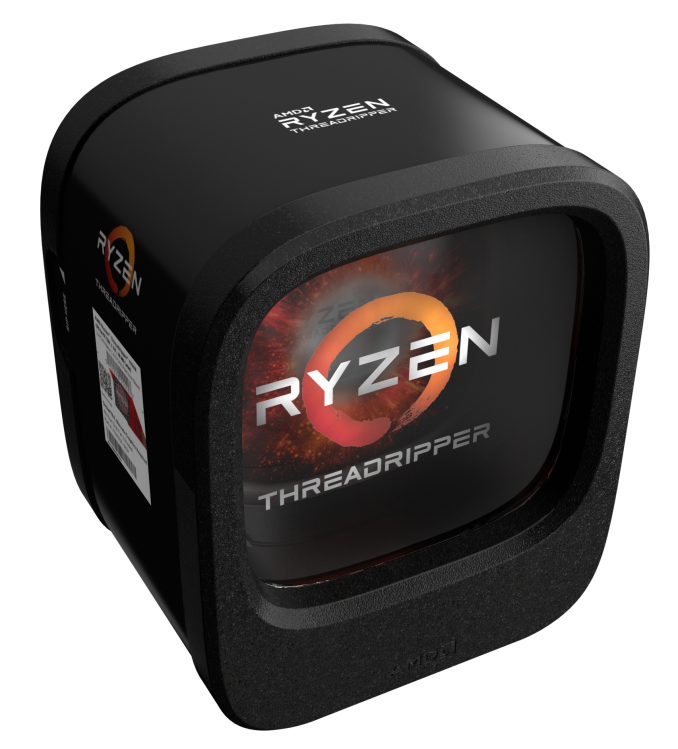
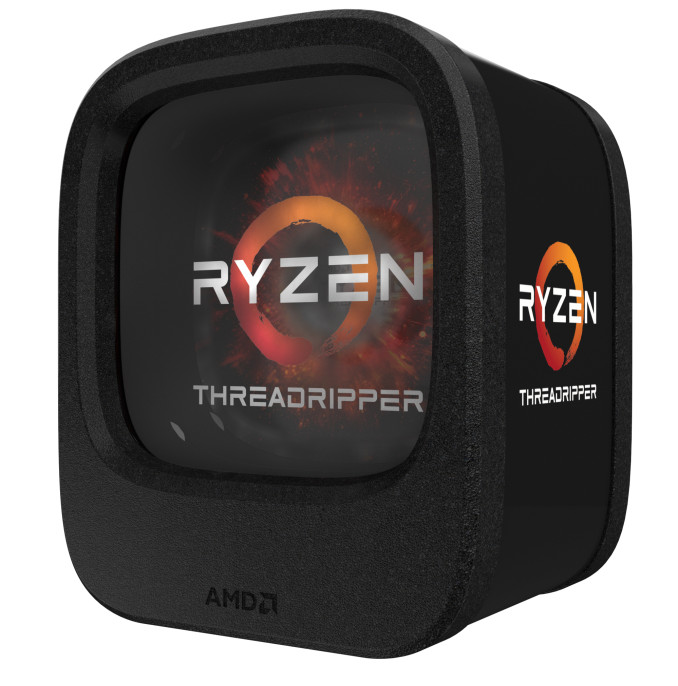
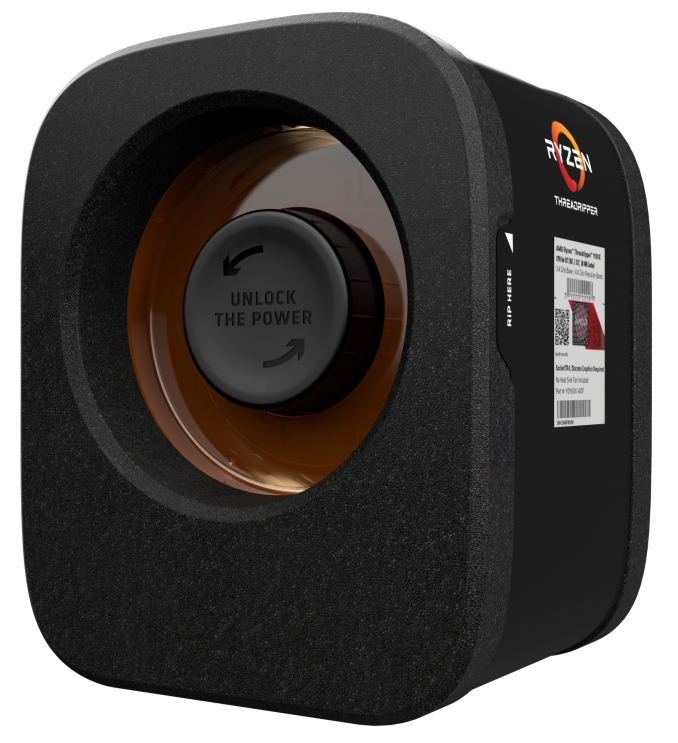

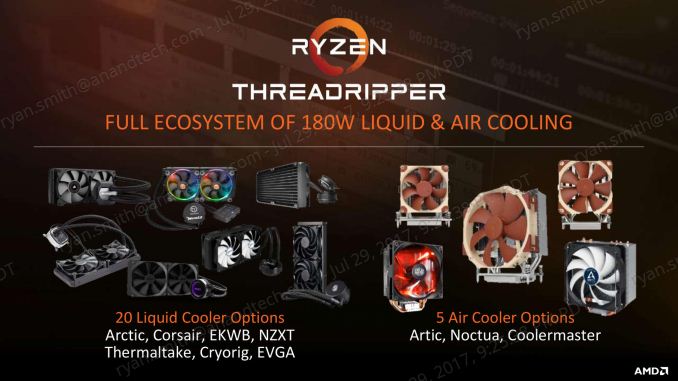








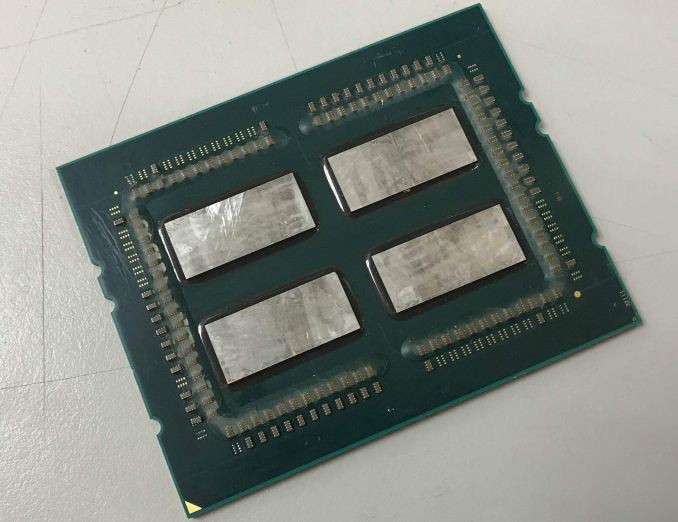














52 Comments
View All Comments
ddriver - Monday, July 31, 2017 - link
"Pin-outs are different, especially with eight-channel memory and the PCIe lanes"Care to provide a source for that claim? To me it looks like TR4 and SP3 are identical, and AMD did it to save on having to develop another whole socket for TR which should be a fairly niche product.
If intel shoehorned desktop chips in a hedt socket, despite it has half of everything and doesn't utilize more than half of the pins, it doesn't seem far fetched for AMD to do something similar.
I don't say that you'd be able to put TR in an Epyc socket or vice versa and get it to work. I just say the two sockets are actually the same physical socket, the same number of pins, and I highly doubt AMD has the motivation to waste resources or making pinouts different, when there is no need to and it will actually require a lot of extra work for no actual benefit.
Ian Cutress - Monday, July 31, 2017 - link
Yes, it's the same physical socket, like 775 and 771 were. But we're told the pin-outs are different.msroadkill612 - Tuesday, August 1, 2017 - link
Its official - DONT put a TR in an epyc mobo socket. It wont work and may fry.msroadkill612 - Sunday, July 30, 2017 - link
Delightfully put:"One of AMD’s skills in recent quarters is the ability to drip feed information about upcoming products slowly to the point where even the breath of a clock speed becomes another several column inches about an upcoming platform."
I feel played, but its been fun - like a treasure hunt.
AMD are sure executing their marketing well, and as you say, getting advertising you cant buy, for a song.
msroadkill612 - Sunday, July 30, 2017 - link
re:"the main four companies ....
ASRock, ASUS, GIGABYTE and MSI will all be launching motherboards on day one,...
We’re planning a full overview of each board,"
It would be a valuable service. Look forward to it.
KAlmquist - Monday, July 31, 2017 - link
I've read suggestions that the EPYC and Threadripper use the same heat spreader, which would explain why AMD needs spacers. In an engineering sample, it's possible that they actually used defective dies as spacers--they would be precisely the right thickness and early runs might have produced a good supply of useless chips. For volume manufacturing, aluminum spacers might make sense, but given the size of the spacers they could afford to use bulk silicon.As for the TR 1900X, it may not end up being a big seller, but I think it at least makes more sense that Intel's i7-7740X. The 7740X plugs into a HEDT board, but you lose the majority of the PCIe lanes and two of the memory channels. In contrast, with 1900X the motherboard is fully functional.
SaturnusDK - Monday, July 31, 2017 - link
I think that if it comes with 4 dies in the retail version, which we don't know for sure yet but seems credible as they could use the exact same tooling as for Epyc saving a lot of process complexity and machinery, then the "disabled" dies would be bulk silicon. You do not want to mix and match materials with vastly different thermal characteristics inside a CPU package. That would be a recipe for disaster.The 1900X makes sense if you view it from the perspective that Threadripper isn't "just" supposed to be a high end desktop but can also replace Xeon workstations in most cases, and here a lower core count variant makes perfect sense due to a good deal of workstation workloads really don't need that many cores but do need a lot of PCIe lanes for GPU acceleration, and lots of ECC RAM.
KAlmquist - Tuesday, August 1, 2017 - link
Good point about the thermal characteristics.serendip - Monday, July 31, 2017 - link
How about adding some Epyc SKUs to the table? I'd like to see how TR pricing compares, especially when Epyc has a lot more PCIE lanes.beginner99 - Monday, July 31, 2017 - link
More puzzling is why they even went with the same size as Epyc. Purely for saving costs on packaging? TR could be a much smaller package and socket which would lead to cheaper mobos and in general lower platform costs.